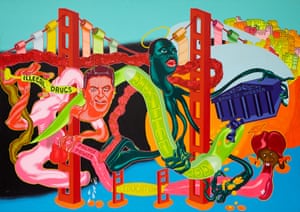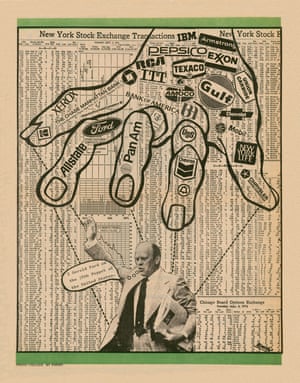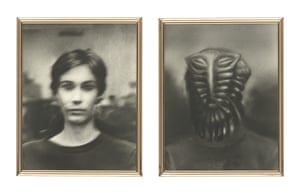Everything is connected: new exhibition on art and conspiracy
Artwork addressing mistrust in the government from the late 60s to the modern day is celebrated in a collection that ‘can inform the present in interesting ways’
In 1974, Black Panthers artist Emory Douglas created a portrait of Gerald Ford, America’s 38th president, being pulled by puppet strings held by giant corporations. A speech bubble had Ford saying: “I Gerald Ford am the 38th puppet of the United States.”
Even 44 years later, this collage – made on a New York stock exchange newspaper page – feels relevant as ever. Douglas, who has always been known to unveil ugly truths about racism and corruption, has been at it long before Black Lives Matter.
This artwork and more will be part of Everything is Connected: Art and Conspiracy, an exhibition at the Met Breuer in New York City. Featuring 70 artworks by 30 artists, the exhibition looks into hidden power, government mistrust and conspiracy with artwork made between 1969 and 2016.
“It’s to tell the stories of artists dealing with conspiracy, and it isn’t about Trump,” said Doug Eklund, co-curator of the exhibit, who works in the Metropolitan Museum of Art’s photo department. “It’s about the archeology of how we got to this place where nobody believes anything any more and we happened to catch the wave at the right moment.”
The 1960s sparked the beginning of conspiracy theories around the John F Kennedy assassination to the Vietnam war, and from there, this exhibition looks at the growing tension between American citizens and their government.
“How does someone imagine the forces that control their lives?” said Ian Alteveer, who co-curated the exhibition with Eklund, and works in the Met’s modern and contemporary art department. “That’s the elevator pitch version of the show.”
It all began in 2010, when Eklund stumbled across a 1991 interview between two artists, New York-based John Miller and the late Los Angeles-based artist Mike Kelley, who longed for an exhibition about art and conspiracy theories. “And the rest is alternative art history,” said Eklund.
The exhibition is divided into two parts. The first section is devoted to uncovering deceit, including one room entitled Wake Up, which Eklund describes as artists reporting on communities in crisis. There are stories about tenants dealing with slumlords, the rise of the black power movement and state-sponsored violence against minorities. “The exhibition looks at how artists represent political power in the postwar world that is inscrutable and not transparent,” said Eklund.
One of the artworks is a conspiracy chart by Mark Lombardi, mapping the connections between Bill Clinton and the controversial Lippo Group’s James Riady, who pledged $1m to Clinton’s presidential campaign. There is also a cartoonish portrait of a sly-looking Lee Harvey Oswald, who assassinated Kennedy in 1963, by Wayne Gonzales.
The second part of the exhibition looks into the fantastical side of conspiracy theories. “If half of the artists in the show are concerned with facts and research, the other half go down the rabbit hole,” said Alteveer. “Slowly, the show goes down a rabbit hole, so by the end of it, its phantasmagoric, dark and weird.”
This section contains the oldest piece in the exhibition, a painting by Peter Saul from 1969. It’s a complex, psychedelic landscape of San Francisco with Ronald Reagan barking alongside the drug crisis and Martin Luther King Jr.
“It was out of the classic counterculture conspiracy theory, that the government was instrumental in funneling hard drugs into the country,” said Alteveer. “From pot and acid to heroin and crack.”
It gets even weirder in the alien portraits of Jim Shaw, who shows diptychs of people alongside their extraterrestrial doppelgangers.
“It’s not a straightforward narrative,” said Eklund. “These artists render things visually in way journalism can’t, that offers great insight into the exhibition.”
There is also a cut-and-paste ransom collage by Lutz Bacher, entitled Lee Harvey Oswald Interview, from 1976. “By making connections between disparate elements, it illustrates how artists use conspiracy theories to make other points,” said Eklund.
There are also comic drawings by Raymond Pettibon, who has used coup d’etats from the 1980s alongside subjects like Richard Nixon and Kennedy to suggest larger narratives.
“Conspiracy is not new, has been with us for a long time,” said Alteveer. “We’re using conspiracy as a figure or a motif, a way into how artists describe political power.”
However, while some of the works show history from a vantage point, past narratives could still be repeating themselves. “We’re looking backwards,” said Alteveer. “What’s in the exhibit can inform the present in interesting ways.”



Comments
Post a Comment